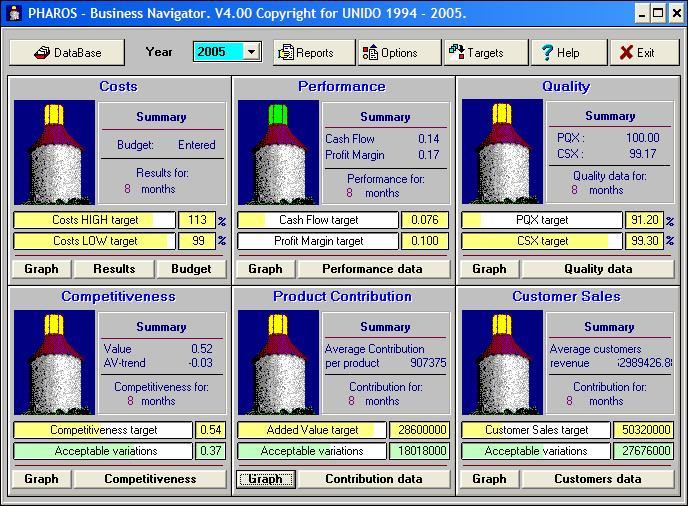1995 Pharos Business Navigator

The first version of Pharos Business Navigator was developed for UNIDO by GOLEM IMS GMBH, Austria in 1995 as single user PC application package running under Microsoft Windows 3.1. The initial UNIDO guidance and support for this project was provided by Dr. Octavio Maizza-Neto, former Director, Metrology and Standardization Branch. The methodological contribution and basic enterprise economic models were provided by Prof. Per Lind, Stockholm, Sweden as UNIDO International Consultant.
The software objectives as set by UNIDO were to provide managers of small and medium enterprises in developing countries with simple and easy to use tools for business navigation and performance management. The system was demonstrated and implemented at the African Regional Centre for Technology (ARCT) in Dakar in 1996. The Pharos software had the following main economic indicators:
- Costs
- Performance
- Quality
- Competitiveness
- Product Contribution
- Customer Sales
The results were calculated accordingly to formulas defined by each economic indicator and presented in graphs as time series. The package had simple, easy to use interface and hypertext format help. Users could see main indicators values in the graphs or in the format of the “Lighthouse” with green, yellow or red lights. Each light provided easy indication of the major business efficiency and competitiveness. The lights and graphs were available only after all data sets had been entered and its changing took place after some new monthly data about business results were provided by user indicating change against user defined targets.
The Pharos software system was especially designed for inexperienced users with little knowledge of PC and business economics. It could run on any PC under any Windows version up to XP with graphics resolution 640*480 pixels or 800*600 pixels, 256 colors for images, required 3 MB on hard disk. Multiple application databases can be developed by the user within the framework of one installation.
During the years of its implementation in UNIDO programmes there were above 3000 installation worldwide mainly in UNIDO capacity building, SME management training and industrial updating programmes for entrepreneurs.
2025 © GOLEM IMS GMBH, Austria. ALL Rights Reserved.
Terms of Service |
Privacy Policy
Made in Austria

